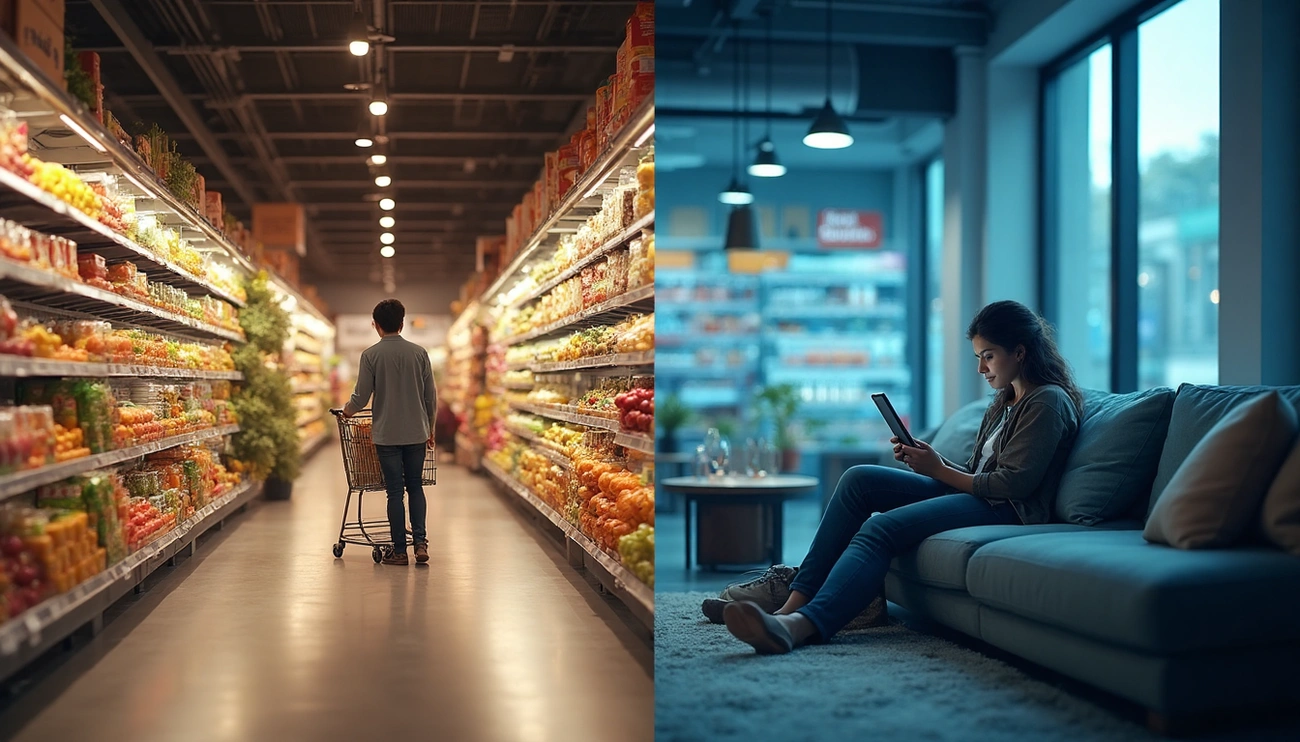Online grocery shopping has transformed how we stock our kitchens, but does it actually save time and money compared to traditional store visits? The average shopper spends nearly an hour navigating aisles during each in-store trip, while digital orders can be completed in minutes. However, convenience often comes with costs—delivery fees and premium pricing might offset the time savings for many households.
While in-store shopping lets you personally inspect produce and catch unadvertised deals, online platforms offer algorithmic savings and shield you from impulse purchases. Both options present distinct advantages depending on your shopping habits and priorities. Additionally, factors like delivery windows, membership benefits, and even your proximity to physical stores significantly impact which method truly serves you better.
This comparison examines exactly where each approach saves or costs you more—both in minutes and dollars—so you can make the smartest choice for your household in 2025.
Time Efficiency: Online vs In-Store
Time has become the most precious commodity for modern shoppers, making efficiency a key factor when choosing between online and in-store grocery shopping methods. The contrast in time investment between these two approaches is substantial across several dimensions.
Shopping Duration: 10 Minutes Online vs 1 Hour In-Store
First and foremost, the time difference between physical and digital grocery shopping is striking. Traditional grocery shopping requires a physical trip to and from the store, searching through shelves, and navigating crowds—a noticeably more time-consuming process than clicking items into a virtual cart [1]. According to research, online grocery shopping can save consumers an impressive average of 2.5 hours per week compared to traditional shopping methods [2].
This efficiency becomes particularly valuable for parents. As one mother with small children notes, the hour typically spent in-store each week transforms into just minutes of online ordering while relaxing at home. She completes her shopping list from the comfort of her couch while spending quality time with her children [3]. Many women with children specifically mention avoiding the stress of taking children into stores, where “pester power” often leads to unwanted purchases of unhealthy items [4].
Checkout Process: One-Click vs Long Queues
In-store shopping frequently involves the frustration of waiting in checkout lines, especially during peak hours. Conversely, online grocery platforms allow shoppers to search for products easily, add items with a simple click, and check out whenever convenient [4]. The entire process includes reviewing your cart, logging in, entering delivery information, selecting payment methods, and confirming your order—all without standing in physical queues [4].
The importance of a streamlined checkout cannot be overstated. Research reveals that 39% of UK consumers are less likely to shop with retailers offering lengthy or confusing checkout processes [5]. Furthermore, a positive checkout experience significantly impacts customer loyalty, with more than half of shoppers saying it shapes their opinion of a store more than advertising [4].
Delivery Time vs Travel Time
Beyond the shopping process itself, comparing travel time against delivery waiting time reveals additional efficiencies. Most grocery deliveries operate on a next-day or scheduled basis, with customers selecting their preferred delivery day and time slot [6]. For those needing faster service, some urban areas offer instant delivery within 15-30 minutes [7].
Click-and-collect models provide another time-efficient option. These services saw rising demand during the pandemic when delivery slots were limited [7]. By January 2023, they accounted for 57.9% of all online grocery orders [8].
The environmental benefits complement the time savings. Research shows that substituting consumer car trips with last-mile delivery vans making multiple drops can reduce total shopping vehicle kilometers by 60-80%, depending on drop density and van load factors [6]. A Seattle case study demonstrated potential vehicle kilometer reductions of 85-95% [6].
Even delivery waiting time is perceived differently than travel time. During the pandemic, researchers found the value of delivery time savings decreased from 10.8 CHF/day to 7.4 CHF/day, indicating shoppers developed increased patience when waiting for grocery deliveries compared to making physical trips [9].
Cost Comparison: Where Do You Save More?
Money matters take center stage in the debate between online and brick-and-mortar grocery shopping. Beyond the obvious time differences, financial considerations often determine which option ultimately serves shoppers better.
Product Pricing: Online Discounts vs In-Store Deals
The pricing landscape between online and in-store groceries shows significant variations. Research reveals that ordering groceries via delivery apps can cost more than a third extra compared to buying directly from supermarkets—even before delivery charges [10]. In extreme cases, some items cost twice as much through apps, with one study finding Warburtons Toastie bread priced at £2 on delivery apps versus £1 at the store [10].
Nevertheless, this pricing disparity isn’t universal. When comparing major online retailers:
- FreshDirect totals averaged only £1.29 more than in-store shopping (without accounting for gas savings) [11]
- Some retailers like Morrisons showed a 34% markup through Uber Eats and 15% through Deliveroo [10]
- Waitrose products cost 21% more through Deliveroo than their website [10]
Moreover, loyalty programs can offset these differences. For instance, subscribing to FreshDirect’s DeliveryPass makes their prices slightly cheaper than physical stores [11].
Hidden Costs: Delivery Fees vs Fuel and Parking
Beyond product prices, several hidden costs affect the total expenditure. Online shopping typically includes:
- Delivery fees ranging from 50p to £6 depending on order size [10]
- Service fees between 50p and £2.99 [10]
- Minimum order thresholds (£25 at Sainsbury’s/Morrisons, £40 at Asda/Iceland/Waitrose) [10]
- Surcharges for smaller orders (£7 at Sainsbury’s/Morrisons, £3 at Waitrose) [10]
In contrast, physical shopping involves travel expenses that many overlook. Fuel costs, parking fees, and public transport fares can substantially increase the actual cost of in-store shopping [12]. Consequently, those living far from stores may find delivery charges more economical than transportation expenses.
Impulse Buying: Controlled Online vs Spontaneous In-Store
Perhaps the most substantial yet overlooked financial benefit of online grocery shopping is reduced impulse purchasing. Multiple studies confirm this advantage:
A scientific study published in PubMed found that when shopping online, participants spent less money per transaction on candy (-£0.52), cold or frozen desserts (-£0.41), and grain-based desserts (-£1.02) compared to in-store purchases [13].
Furthermore, 46% of respondents reported choosing online pickup specifically to reduce impulse purchases, while 36% of delivery app users noted it helped them avoid unnecessary purchases [14]. As one study participant explained, “Less impulse shopping made online shopping more economical” [15].
Despite these advantages, the correlation between online shopping and higher grocery expenditure deserves attention. Research indicates that online shoppers tend to spend more overall—41.5% of online shoppers spent more than £158.83 weekly on groceries compared to 21.8% of in-store shoppers [16]. This suggests that although individual purchases might contain fewer impulse items, the convenience factor may lead to larger total orders.
Product Access and Availability
Product selection and availability represent crucial differentiators between digital and physical grocery shopping experiences. The way items are stocked, tracked, and presented fundamentally affects shopping satisfaction for both methods.
Stock Variety: Niche Items Online vs Essentials In-Store
The inventory landscape differs substantially between online platforms and physical stores. Research reveals that physical supermarkets typically offer more unique SKUs (50,991) than their online counterparts (29,868) [1]. This contradicts the common assumption that virtual stores provide greater variety. Unlike digital platforms, brick-and-mortar stores are restricted by physical space and location [3].
Yet this difference varies by product category:
- Online stores excel at offering niche and specialty products often unavailable locally
- Physical stores maintain broader everyday selections due to established distribution networks
- Bulky items like soft drinks and alcoholic beverages see higher online purchase rates [1]
Indeed, digital grocery channels enable access to specialty items particularly valuable in food deserts, where nearly 420,000 Quebecers lived in 2019 [17]. Initially appealing to digitally literate shoppers seeking specific items, online grocery has subsequently evolved to serve broader demographics.
Inventory Updates: Real-Time Online vs Manual In-Store
Inventory accuracy presents a persistent challenge in both environments. In physical stores, approximately 56% of perpetual inventory records contain inaccuracies [18]. Likewise, even advanced online operations face issues with inventory precision, resulting in about 1-2% of grocery order lines being canceled due to stockouts [19].
Online platforms offer distinct inventory management advantages. Many provide real-time stock notifications—once out-of-stock products become available, customers receive immediate alerts [3]. Furthermore, digital inventories can combine real-time tracking with predictive demand forecasting, allowing customers to see which items will be available at future dates [19].
In contrast, physical stores often rely on manual inventory counts or vendor-managed inventory for certain product categories. This approach, primarily undertaken with items like soda and snacks, results in less frequent updates [20]. Given that inventory typically accounts for 60-70% of total sales in grocery, even minor counting errors significantly impact profitability [18].
Fresh Produce: Visual Inspection vs Product Images
Fresh produce remains the most contested category between shopping methods. A considerable majority of shoppers—61% of European consumers—prefer to physically inspect fresh items before purchasing [21]. This preference is even stronger in certain countries, with 78% of French shoppers wanting to check produce quality personally [21].
The sensory experience of selecting fresh items creates a substantial advantage for physical retailers. Among U.K. consumers, 55% who tried online grocery shopping stated they wouldn’t buy fresh food online again or weren’t interested in doing so, citing the inability to see, smell, and touch products [8].
Research confirms this behavioral difference: families who shop online report significantly lower frequency of buying fresh produce (OR = 0.34) and meat/seafood (OR = 0.29) compared to their in-store habits [22]. As one shopper explained, “In-person, you can see what products are available. If they’re on the shelf, you can buy them” [23].
Interestingly, dairy products face fewer barriers to online purchasing. Approximately 65% of online shoppers buy cheese and 61% purchase yogurt and chilled desserts through digital channels [21]. In essence, the more trust required in product freshness, the more consumers favor in-person shopping.
User Experience and Convenience
Convenience stands at the heart of the modern shopping experience, with distinct differences between digital and physical grocery environments. These differences fundamentally shape how consumers interact with retailers across multiple dimensions.
24/7 Access: Online Platforms vs Store Hours
The freedom to shop anytime represents a fundamental advantage of digital grocery platforms. Online stores operate round-the-clock, freeing customers from the constraints of traditional business hours [24]. This accessibility proves particularly valuable for night shift workers, parents with unpredictable schedules, and those with mobility limitations.
Even more compelling, research shows 72% of consumers find online grocery shopping more convenient than visiting physical stores [25]. This accessibility extends across multiple devices, as modern platforms deliver consistent experiences whether accessed via smartphone, tablet, or computer [25].
For immunocompromised individuals or those with disabilities, this 24/7 access becomes more than convenience—it transforms into an essential service. As one researcher noted, online grocery shopping can be “a literal lifesaver” for homebound populations [26].
Ease of Navigation: Search Bars vs Aisle Browsing
Navigating a virtual store differs dramatically from walking physical aisles. 69% of shoppers head directly to search when visiting e-commerce sites, making search functionality the primary navigation tool [4]. This behavior highlights how differently consumers approach online grocery shopping.
Modern e-commerce platforms enhance this experience through:
- Powerful search tools with auto-complete functionality
- Intuitive categorization of products
- Effortless checkout processes [25]
In contrast, physical store navigation depends heavily on store layout, signage quality, and shopper familiarity. Though many enjoy the sensory experience of walking aisles, others find it time-consuming—especially during peak hours [5].
Personalized Recommendations and Reordering
Perhaps the most significant advantage of online grocery platforms is their ability to learn from shopping patterns. Data shows that over 70% of a typical order consists of previously purchased products [4]. AI-powered platforms leverage this behavior by generating whole or partial orders automatically.
This level of personalization extends beyond simple reordering. Advanced algorithms analyze shopping patterns to recommend complementary products and suggest new items based on similar customers’ preferences [27]. The business impact is substantial—McKinsey research indicates personalization can increase revenues by 5-15%, with fast-growing retailers deriving 40% more revenue from these capabilities than slower-growing competitors [4].
Rather than forcing customers to rebuild shopping lists from scratch, intelligent platforms allow for easy repetition of past purchases with minimal effort [28]. This combination of convenience and personalization creates a user experience physical stores simply cannot replicate.
Security, Returns, and Customer Support
Behind every successful shopping experience lies a framework of security measures, return policies, and customer support systems that vary significantly between digital and physical grocery environments.
Return Policies: App-Based vs Physical Returns
The distinction between online and in-store returns is substantial, primarily evident in return rates—nearly 30% of products bought online are returned compared to just 8.89% from brick-and-mortar stores [29]. This difference stems largely from inability to physically inspect products before purchasing. Online retailers typically offer more standardized return policies, with many platforms providing “no questions asked” returns to build consumer confidence.
For online purchases, consumers possess stronger legal protections. Under distance selling regulations, customers have the right to cancel orders within 14 days of receiving goods [30]. Following notification, they have another 14 days to return items, with refunds legally required within 14 days of the retailer receiving returned goods.
In-store purchases, conversely, fall under different rules. Physical retailers aren’t legally obligated to accept non-faulty returns, though most establish “goodwill” return policies [31]. Without receipts, stores typically offer exchanges or credit notes rather than refunds.
Customer Support: 24/7 Chat vs In-Store Help Desk
The proportion of UK retailers offering round-the-clock customer service support has doubled since 2022—growing from 14% to 28% [32]. Additionally, 80% of leading retailers now provide customer service outside traditional business hours [32].
Online grocery platforms increasingly utilize live chat and chatbots for instant assistance, with satisfaction rates reaching 89% for live chat [33]. These digital tools allow for proactive support—offering help before customers request it.
Nonetheless, phone support remains vital for complex issues, with 91% of service professionals reporting it as the preferred channel for complicated situations [9]. Physical stores maintain an advantage through immediate face-to-face assistance during operating hours.
Trust and Safety: Verified Sellers vs Physical Inspection
Payment security concerns vary between shopping methods. Most online grocery shoppers use PayPal, Apple Pay, or saved debit cards for convenience and security [6]. Interestingly, regular online shoppers show minimal concern about using bank details for food purchases [6].
However, trust issues emerge with unfamiliar platforms or individual sellers. Cash payments requested through marketplace platforms often raise red flags about seller legitimacy and food safety standards [6]. Consequently, established online grocers build trust through secure payment options, responsive support, and transparent pricing [25].
Conclusion
The battle between online grocery shopping and traditional in-store experiences ultimately comes down to personal priorities. Time-conscious shoppers benefit greatly from digital platforms, saving an average of 2.5 hours weekly compared to physical store visits. Additionally, the streamlined checkout process eliminates frustrating queues, making online shopping particularly valuable for parents and busy professionals.
Cost considerations present a more nuanced picture. While delivery fees and sometimes higher product prices can increase online shopping expenses, reduced impulse purchases often offset these costs. Furthermore, transportation expenses for in-store shopping—fuel, parking, and public transport—frequently go uncalculated when comparing options.
Product selection varies significantly between both methods. Physical stores generally offer greater overall variety with almost 51,000 unique items compared to online platforms’ 30,000. Nevertheless, digital grocery excels at providing niche and specialty products. Fresh produce remains the most contested category, with 61% of European consumers preferring to physically inspect these items before purchase.
User experience differs dramatically between platforms. Online grocery shopping provides 24/7 accessibility regardless of store hours, search functionality that simplifies product location, and AI-powered personalization that remembers past purchases. These conveniences explain why 72% of consumers find online grocery shopping more convenient than visiting physical stores.
Security measures and customer support systems round out the comparison. Online platforms typically offer standardized return policies with stronger legal protections, while physical stores provide immediate face-to-face assistance during business hours. Trust factors play differently across both methods, with established online grocers building confidence through secure payment options and responsive support.
The smartest approach for many households lies somewhere between both worlds—perhaps ordering shelf-stable items and repeatable purchases online while visiting stores for fresh produce and specialty items. This hybrid strategy allows shoppers to maximize the strengths of each method while minimizing drawbacks. As digital platforms continue evolving and traditional stores enhance their experiences, the ideal grocery solution will likely become increasingly personalized to each shopper’s unique circumstances and preferences.
References
[1] – https://www.sciencedirect.com/science/article/pii/S1567422323001011
[2] – https://retail.yango-tech.com/blog/why-e-grocery-wins-over-traditional-retail-11-e-grocery-benefits
[3] – https://www.csigrocery.com/supermarket-vs-online-grocery-shopping/?srsltid=AfmBOootsC_zVICp2CaUq3UdjaW1kxEoWCkuLu5bmLPtD76PFwgFDy2L
[4] – https://www.ocadogroup.com/media/stories/how-ai-redefines-customer-experience-online-grocery
[5] – https://posin.com.sg/blogs/news/grocery-shopping-showdown-online-vs-in-store-which-offers-the-best-features-usability-and-pricing?srsltid=AfmBOopVdD44LHJfrHOgzAarYu75FeMANGbVayPYF0Sn6gP8OQPrtdw5
[6] – https://www.food.gov.uk/research/chapter-2-attitudes-towards-and-perceived-risk-of-buying-food-online
[7] – https://www.mckinsey.com/industries/retail/our-insights/the-next-s-curve-of-growth-online-grocery-to-2030
[8] – https://www.oliverwyman.com/our-expertise/insights/2019/dec/uk-customer-fresh-survey.html
[9] – https://www.salesforce.com/retail/customer-service-software/guide/
[10] – https://www.theguardian.com/business/2023/jun/03/delivery-apps-supermarket-goods-markup-which
[11] – https://www.cnet.com/home/kitchen-and-household/heres-how-much-it-costs-to-have-groceries-delivered-versus-shopping-in-person/
[12] – https://metro.co.uk/2023/04/18/is-it-cheaper-to-buy-groceries-online-or-in-the-supermarket-18587373/
[13] – https://pubmed.ncbi.nlm.nih.gov/34116742/
[14] – https://www.modernretail.co/marketing/brands-and-retailers-are-still-trying-to-figure-out-the-secret-to-impulse-purchases-in-online-grocery/
[15] – https://pmc.ncbi.nlm.nih.gov/articles/PMC10260851/
[16] – https://www.sciencedirect.com/science/article/pii/S0040162523003839
[17] – https://www.onetrip.io/en/posts/sell-online-or-in-store-what-is-the-best-option
[18] – https://www.ordergrid.com/blog/from-shelf-to-system-the-power-of-real-time-store-inventory-management-in-grocery
[19] – https://www.forbes.com/councils/forbestechcouncil/2024/12/19/mastering-inventory-management-for-the-rapidly-growing-online-grocery-market/
[20] – https://www.oracle.com/uk/retail/grocery-inventory-management/
[21] – https://packagingeurope.com/new-research-reveals-consumers-online-grocery-shopping-habits-for-fresh-foods/5060.article
[22] – https://www.sciencedirect.com/science/article/pii/S0195666322001295
[23] – https://www.voxpopme.com/learn/blog/groceries-the-latest-online-shopping-vs-in-store-shopping-research/




